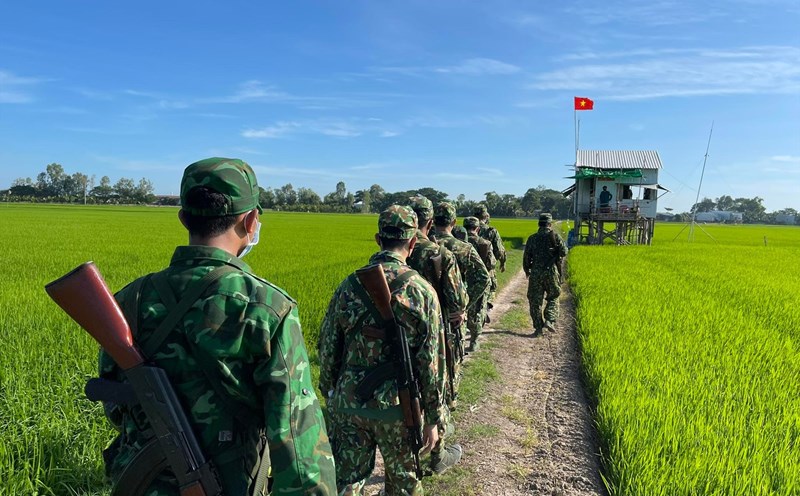Contents of protecting defense works and military areas in Vietnam as of January 1, 2025
What are the contents of protecting defense works and military areas in Vietnam as of January 1, 2025? - Hoang Hai (Tay Ninh)

Contents of protecting defense works and military areas in Vietnam as of January 1, 2025 (Internet image)
Regarding this issue, LawNet would like to answer as follows:
1. Contents of protecting defense works and military areas in Vietnam as of January 1, 2025
The contents of protecting defense works and military areas according to Article 16 of the Law on Management and Protection of National Defense Works and Military areas 2023 are as follows:
- Determine the scope of protection of national defense works and military areas.
- Develop and implement plans for protection, prevention of acts that undermine the safety and secrecy of defense works and military areas; prevention of natural disasters and fires.
- Ensure the safety of personnel, weapons, support tools, technical vehicles, and material facilities in the management and protection of defense works and military areas; build stable security, political order, and social safety in areas where defense works and military areas are located.
2. Regulations on determining the scope of protection of national defense works and military areas in Vietnam
The regulations on determining the scope of protection of national defense works and military areas according to Article 17 of the Law on Management and Protection of National Defense Works and Military areas 2023 are as follows:
- The prohibited area of defense works and military areas is determined based on the type, group, management and protection requirements, position, terrain conditions, and population where defense works and military areas are located, and is regulated as follows:
+ The prohibited area of defense works is determined within the boundaries of land and water use and an extension from those boundaries. The extension is determined for each type and group of defense works, not exceeding 55 meters on land and 500 meters on water.
+ The prohibited area of military areas is determined within the boundaries of land and water use of the military area or the airspace of the military area when established in the air.
+ The prohibited area within the ground, underwater, and airspace of defense works and military areas is determined by the vertical plane from the boundary line of the prohibited area from the ground or water surface downwards without depth limitation and upwards not exceeding 5,000 meters in height.
+ The prohibited area is represented on diagrams, maps, and in the field; it may have walls, fences, ditches, markers, signs, and buoys to determine the boundaries.
- The protection area of defense works and military areas is determined from the boundaries of the prohibited area outward at a certain distance for each type and group, represented on diagrams, maps, and in the field, with markers, signs, and buoys to determine, and is regulated as follows:
+ The distance from the boundaries of the prohibited area outward of special group defense works and military areas is not more than 600 meters, Group I is not more than 300 meters; and Group II and Group III are not more than 200 meters.
+ For defense works that ensure the equipment of weapons, the protection area is determined based on the tactical and technical characteristics, ensuring that it does not affect the effectiveness of using each type of weapon.
- The scope of the safety belt of defense works and military areas is calculated from the outer boundary of the protected area or the prohibited area around a certain distance according to the type, group, management and protection requirements, position, terrain conditions, and population, as shown on diagrams, maps, and documents of the competent authority, and is regulated as follows:
+ The safety belt of defense works and military areas of the Special Group is determined by the Prime Minister;
+ The safety belt of defense works and military areas in Group I, Group II, and Group III is not more than 1,500 meters.
- The scope of the safety belt of ammunition depots is determined from the inner limit outward with a safety radius shown on diagrams, maps, and in the field, with markers, signs, buoys, or barriers to determine, and is regulated as follows:
+ The inner limit of the safety belt of ammunition depots is a distance from the basic road of the ammunition depot not exceeding 55 meters; for ammunition depots under district-level military command and equivalent, the inner limit is the same as the basic road;
+ The safety radius is determined based on the level of the ammunition depot; the quantity and stockpile of each type of ammunition and explosive materials stored in the depot are calculated and converted into equivalent TNT.
The safety radius of ammunition depots in Group I and Group II is from 1,200 meters to 1,500 meters; the safety radius of ammunition depots in Group III is from 800 meters to 1,000 meters; for ammunition depots under district-level military command and equivalent, the safety radius is from 14 meters to 800 meters;
+ In case the ammunition depot is surrounded by terrain or obstacles that meet the technical requirements, the safety radius specified at point b of this provision may be reduced, but not more than 50%;
+ The scope of the safety belt of ammunition depots within the ground, underwater, and airspace is determined by the vertical plane from the outer boundary of the safety belt on the ground, the water surface downwards without depth limitation, and upwards not exceeding 5,000 meters in height.
- The scope of the technical safety corridor of military antenna systems is determined based on the technical characteristics of each military antenna system and is regulated as follows:
+ The technical safety corridor of communication antenna systems is 2,000 meters; the technical safety corridor of reconnaissance antenna systems is 3,000 meters; and the technical safety corridor of radar and electronic warfare antenna systems is 5,000 meters;
+ Obstacles to antennas within the technical safety corridor of military antenna systems must be a minimum distance from the outer edge of the military antenna system to avoid affecting the operation of the military antenna system; the determination of the minimum distance is based on the technical characteristics of each antenna system and the characteristics of the obstacle.
- The protection scope of defense works and military areas specified at points a and d of Clause 5 of Article 6 of the Law on Management and Protection of National Defense Works and Military areas 2023 only defines the prohibited area without defining the protection area and safety belt.
More details can be found in the Law on Management and Protection of National Defense Works and Military areas 2023, taking effect on January 1, 2025.
The Ordinance on Management and Protection of National Defense Works and Military areas 32-L/CTN, dated May 19, 1994, expires on January 1, 2020.
- Key word:
- military areas
- in Vietnam
- Vietnam
- Guidelines for maintenance and renovation of villas in Ho Chi Minh City
- Guidelines for maintenance and renovation of villas in Ho Chi Minh City
- Resolution 190: Principles for addressing certain issues related to the organization and arrangement of state apparatus in Vietnam
- Guidance on identifying cases of inaccurate or non-operational electricity meters in Vietnam
- Official Telegram 16: Urgent requirement to allocate the entire state budget investment plan in 2025 in Vietnam
- Prime Minister of Vietnam directs to accelerate allocation and disbursement of public investment capital in 2025 in Vietnam
-

- Procedures for high school admission in Vietnam
- 14:25, 21/02/2025
-

- Resolution 190: Principles for addressing certain ...
- 11:30, 21/02/2025
-

- Guidance on identifying cases of inaccurate or ...
- 11:00, 21/02/2025
-

- Official Telegram 16: Urgent requirement to allocate ...
- 08:00, 21/02/2025
-

- Circular 04/2025 stipulating on the quality assessment ...
- 18:41, 20/02/2025
-

- Guidelines for maintenance and renovation of villas ...
- 14:30, 21/02/2025
-

- Guidelines for maintenance and renovation of villas ...
- 14:30, 21/02/2025
-

- Procedures for high school admission in Vietnam
- 14:25, 21/02/2025
-

- Resolution 190: Principles for addressing certain ...
- 11:30, 21/02/2025
-

- Guidance on identifying cases of inaccurate or ...
- 11:00, 21/02/2025

 Article table of contents
Article table of contents
